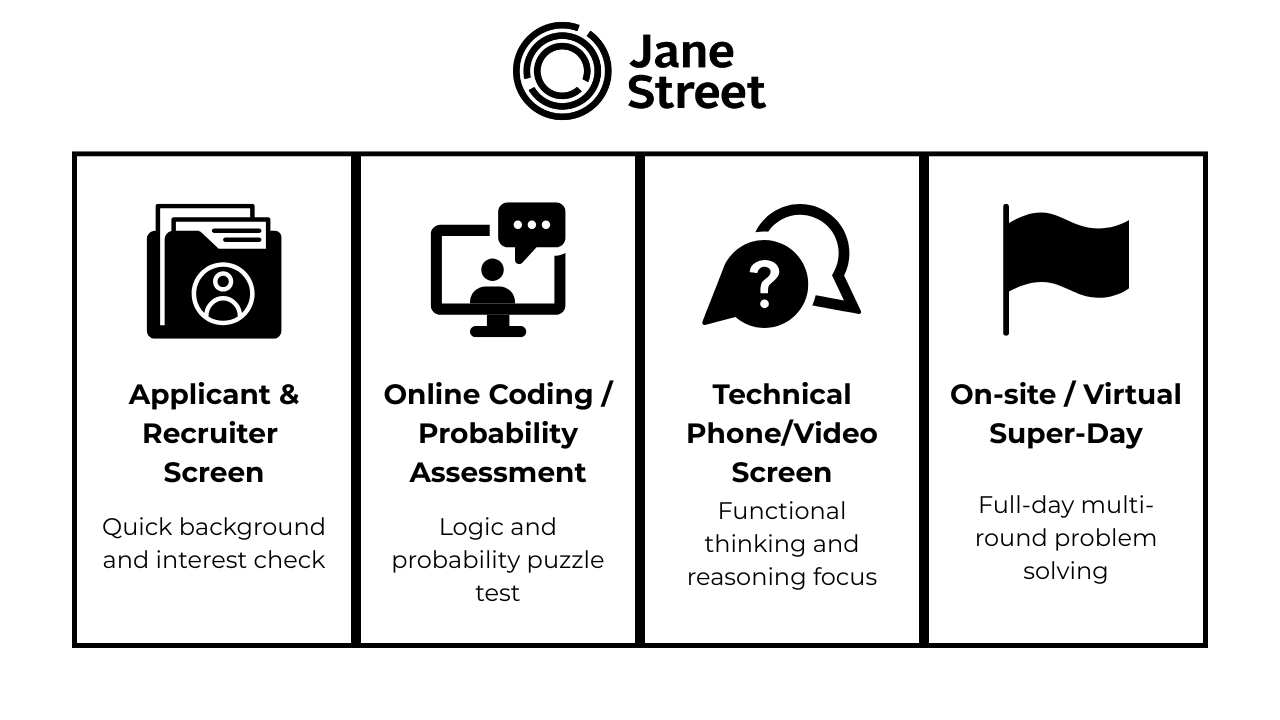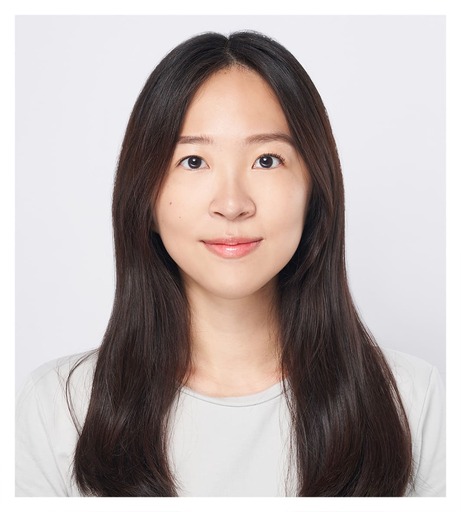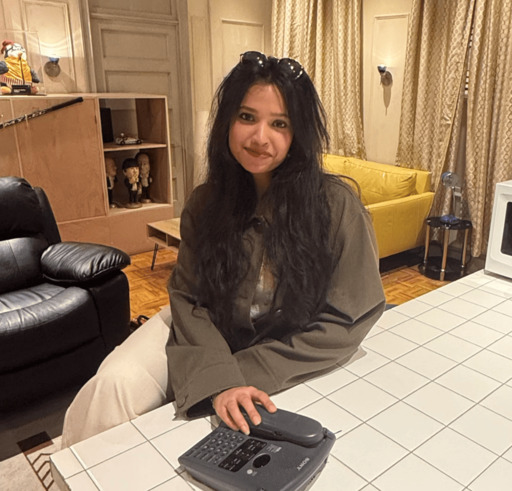Jane Street Interview Questions & Process Guide (2025)
Introduction
Jane Street interview questions are famously difficult and often cited as some of the toughest in tech and finance. Jane Street is a global quantitative trading firm that leverages advanced technology and mathematical research to make markets more efficient. Whether you’re applying for a quant trading, software engineering, or internship role, the Jane Street interview process is known for its relentless pace, time-pressured logic puzzles, and deep emphasis on mental math and functional programming.
Unlike typical interviews, Jane Street challenges how you think, not just what you know—favoring abstract reasoning, quick iteration, and collaborative problem-solving over rote algorithms or resume facts. This reputation for rigor draws in highly competitive candidates who search for these questions to prepare for what may be the most intellectually demanding interview of their careers.
In this guide, you’ll find a step-by-step look at the Jane Street interview process and the questions that surface most often.
Why Work at Jane Street?
Beyond the challenge of a Jane Street interview, candidates are drawn to a culture that blends intellectual rigor with meaningful mentorship, outstanding pay, and cutting-edge tech. If you’re excited by deep problem-solving and collaborative environments, Jane Street offers a uniquely rewarding place to grow.
Flat Hierarchy & Mentorship
Jane Street fosters a low-ego, highly collaborative workplace where even the most junior hires can pair program alongside veteran quants and engineers. This culture of shared problem-solving is central to success, and why so many prep with a Jane Street interview guide to meet the bar for thoughtful, real-time collaboration.
Competitive Total Compensation
The average Jane Street salary is among the highest in tech and finance—blending generous base pay with performance-based profit sharing. Total compensation can rival or exceed top hedge funds and Big Tech firms (see below for breakdowns).
Cutting‑Edge Tech Stack
Engineers at Jane Street work with a custom-built stack centered on OCaml, supported by highly optimized build systems and internal tooling. The result: a playground for systems thinkers and language lovers who care deeply about correctness and performance.
To become part of this environment, candidates go through a carefully structured interview process that mirrors Jane Street’s values: precision, logical reasoning, and collaborative problem-solving.
What’s Jane Street’s Interview Process Like?

Here’s a high-level breakdown of the Jane Street interview process:
- Application & Recruiter Screen
- Online Coding or Probability Assessment
- Technical Phone / Video Screen
- On-site or Virtual Super-Day
Each stage is designed to test your reasoning under pressure—more than just technical knowledge.
Application & Recruiter Screen
The first step starts with a straightforward online application, often followed by an initial call from a recruiter. This brief screen confirms your interest, timelines, and background. Candidates applying to different roles—like trading, software engineering, or research—may face different requirements, so check Jane Street’s careers page for specifics. This stage kicks off the Jane Street interview process, setting expectations for what lies ahead.
Tips:
- Research Jane Street’s core values and culture so you can articulate why you’re drawn to them specifically.
- Be prepared to explain your role preference clearly (trading, SWE, product) and show awareness of what differentiates them.
- Use the call to ask smart questions about team structure or next steps—it signals curiosity and preparedness.
Online Coding or Probability Assessment
The Jane Street online assessment varies slightly by role. Software engineering candidates may face algorithmic or logic-based questions delivered via HackerRank or similar platforms. Strategy & Product applicants often complete probability-heavy math puzzles designed to test intuition, expected value reasoning, and comfort with abstraction. Each test is time-bound and designed to favor cleverness over brute force. For details by role, see our full assessment breakdown.
Tips:
- Practice mental math and probability puzzles—Jane Street favors clever insights over rote computation.
- For coding, focus less on LeetCode grind and more on clarity of logic, recursion, and elegance.
- Manage your time: don’t get stuck on one problem—show breadth of thinking even if you don’t finish everything.
Technical Phone/Video Screen
The next stage typically consists of one or more 45-minute technical interviews over video or phone. These can be OCaml-based (especially for SWE roles) or language-agnostic, depending on the candidate’s comfort level. Questions center around logical reasoning, recursion, data structures, or mathematical modeling—often designed to reveal how you think, not how much syntax you’ve memorized. This is often referred to as the Jane Street coding interview, where clear thinking and strong fundamentals matter more than knowing a specific API.
Compared to other tech companies like Google or Meta, which may emphasize system design or LeetCode-style algorithmic questions, Jane Street focuses more on mathematical elegance, functional programming principles, and collaborative problem-solving. You’re less likely to be asked about Big-O notation or edge case checks—and more likely to be pushed to reason through a deceptively simple problem with tight constraints and high precision.
Tips:
- Don’t panic if you don’t know OCaml—focus on showing clarity in functional thinking.
- Think out loud: Jane Street values your reasoning path more than the final solution.
- If stuck, ask clarifying questions and demonstrate adaptability—this is part of the evaluation.
- Review recursion, combinatorics, and elegant solutions to small puzzles over brute-force hacks.
On‑site Super‑Day
Top candidates are invited to the final round: the Jane Street onsite interview, which may be held virtually or in person. This Super-Day consists of multiple interviews spanning technical, behavioral, and game-based rounds. For trading roles, you might face fast-paced mental math relays, probability estimation, and market simulation exercises. Software engineering candidates typically work through abstract logic puzzles, recursive algorithms, or systems modeling problems—often with a focus on functional programming. Interviews are whiteboard-based and collaborative, and lunch with the team offers a more informal check for cultural fit. Jane Street usually covers travel and lodging for in-person visits.
More than just a test of raw skill, the Super-Day is designed to uncover how you think. Jane Street looks for candidates who are calm under pressure, intellectually curious, and quick to question assumptions. They value structured reasoning, clear communication, and the ability to solve complex problems collaboratively without ego. Flexibility is key—being able to adapt your approach mid-problem, accept feedback, and iterate in real time. Successful candidates often demonstrate a playful approach to abstract thinking, combining precision with creativity. Whether you’re coding, modeling a market, or tackling a probability game, Jane Street is paying close attention not just to your answers, but to how you engage with the problem, your interviewer, and the ambiguity itself.
Tips:
- Expect a long day—pace yourself mentally and physically, and use breaks to reset.
- Show intellectual curiosity: explain your assumptions and adjust when new information arises.
- Practice staying calm under pressure—speed matters, but composure and structured reasoning are equally critical.
- Use the lunch/culture check to show that you’re collaborative, humble, and genuinely interested in how Jane Street operates.
Most Common Jane Street Interview Questions
Role‑Specific Interview Guides
- Software Engineer → Jane Street Software Engineer interview questions
- Data Engineer → Jane Street Data Engineer interview questions
- Machine Learning Engineer → Jane Street Machine Learning Engineer interview questions
- Strategy & Product → Jane Street Strategy and Product interview questions
Coding & Problem‑Solving Themes
Many Jane Street coding questions revolve around abstract yet elegant problem-solving, often with a twist of functional programming. Expect algorithms that test dynamic programming, recursion, and state machines—but framed in ways that require clean logic and careful thought rather than brute-force solutions. Data structures like trees, graphs, and queues may come up, but the emphasis is on reasoning and clarity, not on memorizing API calls. You might be asked to write in OCaml or pseudocode, with some problems incorporating higher-order functions or immutability constraints. It’s common to be prompted to discuss trade-offs or improve your solution live, so fluency in iterative refinement matters.
Brain Teasers & Probability Puzzles
Jane Street is famously known for its Jane Street brain teasers, which test mental agility, numerical intuition, and probabilistic thinking. You won’t face standard “trick” riddles but rather real-time estimation problems, expected value puzzles, and logic games that mirror the uncertainty and decision-making dynamics of real trading. For example, you might be asked: “You roll a die. You can keep the number or reroll once—what’s your strategy?” Or, “You and a partner each get a coin with a known bias. How do you maximize your win probability if you can only speak once?” These questions aren’t about memorizing answers, but about how you structure your thoughts, explain assumptions, and reason under pressure.
Behavioral & Culture Fit Questions
Though technical skill is vital, cultural fit plays a major role in the hiring decision. Jane Street’s environment values humility, intellectual honesty, and low-ego collaboration. Behavioral questions often explore how you’ve worked through high-stakes problems with others, received critical feedback, or handled ambiguity. You might be asked: “Tell me about a time you disagreed with a teammate—how did you resolve it?” or “Describe a moment when you had to unlearn something to solve a problem better.” Responses should show curiosity, flexibility, and mission alignment. For those prepping, a Jane Street interview questions pdf (downloadable PDF of sample behavioral prompts) can help structure and reflect on relevant personal experiences.
Tips When Preparing for a Jane Street Interview
Master Functional Patterns
Jane Street values clean, elegant code rooted in functional thinking. Whether you’re using OCaml or pseudocode, expect to implement recursive solutions, pattern matching, and immutability principles. Study tail recursion, tree traversals, and higher-order functions. Practicing recursion-heavy problems on platforms like LeetCode can be helpful, though Jane Street’s style often emphasizes correctness and reasoning over speed.
Simulate Pressure
The interview format is fast-paced and interactive. To build comfort, simulate time-boxed rounds where you think out loud, adapt to feedback, and iterate. Try setting a 20–30 minute timer to solve logic puzzles while explaining your steps aloud—then review your recording to spot gaps in clarity or structure. Doing a Jane Street mock interview video call with your friend or mentor are especially effective. Use whiteboards or plain text editors to mimic the minimal setup of actual interviews, and avoid auto-complete or debugging tools to mirror the mental workload of writing clean logic from scratch.
Understand Market Concepts
Prepare for probability questions
All candidates, regardless of whether they’re applying for trading, software engineering, or strategy roles, should be familiar with core concepts in probability and decision theory. Even non-trader interviews frequently include pricing games or abstract decision-making puzzles rooted in uncertainty. You don’t need a background in finance or economics, but a strong grasp of expected value, marginal gain, utility theory, and basic Bayesian reasoning is essential.
For instance, you might be asked to choose between two randomized outcomes with incomplete information, or to optimize your strategy in a multi-round betting game. Interviewers are looking to see how well you quantify uncertainty, articulate trade-offs, and revise your strategy as assumptions change.
To prepare, start by revisiting high-school to early university–level probability—focusing on conditional probability, combinatorics, and expected values. Practice classic problems like Monty Hall, coin toss variations, or urn problems.
For deeper prep, read Jane Street’s “probability and markets” guide, which introduces how market participants think in terms of distributions, incentives, and real-time outcomes. Try framing everyday choices—like commuting routes or food delivery timing—as expected value problems. Developing this mindset will make the probability questions in the interview feel like second nature.
Strategy and systems thinking
For strategy and quant roles, it’s also helpful to be familiar with zero-sum games, Nash equilibria, and risk aversion curves, as well as how these apply in high-frequency trading or market-making contexts. Engineers can benefit from understanding latency, throughput, and fault-tolerant system design, particularly when used to support real-time trading infrastructure. While you won’t necessarily code a full system in the interview, showing that you can think through how technical decisions affect market outcomes gives you a notable edge.
Ask Insightful Questions
At the end of your interviews, you’ll often have the opportunity to ask questions—this is your chance to show curiosity and alignment with the company’s ethos. Strong candidates ask about the interplay between trading and engineering, how decisions are made in ambiguous situations, or how teams balance rigorous theory with real-world constraints. Great questions demonstrate long-term thinking and help you stand out.
Salaries at Jane Street
Most data science positions fall under different position titles depending on the actual role.
From the graph we can see that on average the ML Engineer role pays the most with a $300,000 base salary while the Software Engineer role on average pays the least with a $196,846 base salary.
Jane Street software engineer salary and data engineer salary consistently rank among the highest in both tech and finance, thanks to the firm’s unique profit-sharing model and flat hierarchy. Engineers at Jane Street don’t just write code—they help drive trading performance, and compensation reflects that impact. Below is a salary comparison across Software Engineer (SWE), Data Engineer (DE), and Machine Learning Engineer (MLE) roles:
- Software Engineer (SWE)
- Base Salary: $150K–$200K
- Total Compensation: $250K–$400K+ (Levels.fyi)
- Structure: Heavy profit-sharing bonuses; no equity/RSUs
- Data Engineer (DE)
- Base Salary: $150K–$180K
- Total Compensation: $250K–$350K+ (Indeed)
- Structure: Base slightly lower, but comparable bonus upside
- Machine Learning Engineer (MLE)
- Base Salary: $160K–$200K
- Total Compensation: $300K–$450K+(Levels.fyi)
- Structure: Higher upside with trading infrastructure and ML research exposure
Conclusion
Jane Street interviews are fast-paced, collaborative, and rooted in logic, recursion, and probability. Success depends on clear thinking, creativity, and problem-solving under pressure—not just technical skill. Compensation is top-tier, and the culture values curiosity and humility.
Sharpen your skills with Interview Query’s software engineering interview questions, where you’ll find role-specific problems, patterns from real interviews, and actionable strategies. When you’re ready, take a mock interview to test yourself under realistic conditions and get expert feedback.
FAQs
What is the latest update on Jane Street interviews?
As of 2025, the Jane Street interview latest trend includes tighter time-boxed rounds, increased emphasis on functional reasoning, and continued use of virtual Super-Days for some roles. While core formats remain stable, there’s growing focus on collaboration under ambiguity and open-ended problem-solving—especially in trading and engineering roles.
How many rounds are in the Jane Street interview process?
The Jane Street interview process typically involves four main stages: application and recruiter screen, online coding or probability assessment, technical phone/video screens, and a final onsite or virtual Super-Day. Some roles may include an additional call focused on fit or role-specific context.
Is Jane Street’s acceptance rate really that low?
Yes—the Jane Street acceptance rate is estimated to be under 1% for some roles, especially in quantitative trading and software engineering. This reflects both high application volume and a rigorous, multi-stage interview process designed to identify candidates with exceptional reasoning and communication skills.
Do I need OCaml for every Jane Street role?
Not necessarily. While OCaml is the primary language for engineering teams, many candidates interview using pseudocode or another language they’re comfortable with. Traders and strategists won’t need to code. Our full Jane Street guide outlines what to expect by role, including language expectations and prep resources.
How long does the entire hiring cycle take?
The full Jane Street interviews timeline can range from two to six weeks, depending on scheduling and role. After the online assessment, phone interviews are usually completed within a week or two, followed by a Super-Day. Offers are often extended shortly after the final round.


